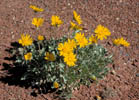
click picture for larger version
Common Name: Nakedstem Sunray
Other Common Names: Nakedstem, False Sunflower
Scientific Name: Enceliopsis nudicaulis
Family: Aster Family (Asteraceae)
Distribution: Great Basin, Uinta Basin, and Colorado Plateau
Habitat: blackbrush, salt desert, mixed desert shrub and pinyon-juniper communities, usually on fine-textured "badlands" soils high in gypsum
Habit: perennial herb
Height:1-1.5'
Spread: to 2'
Foliage Color: pale gray-green
Leaves: thick, silvery-hairy, rounded at the end, tapering to the base, all basal, 2-8" long
Flower Color: golden yellow
Flower Form: flowers in heads 2-4" across, with both ray and disk flowers, borne singly at the tips of naked flowering stems
Cultural Requirements: Prefers full sun and very well-drained soils. Fully cold-hardy. Drought hardy (i.e., needs no supplemental water after establishment on the Wasatch Front) and very intolerant of overwatering and excessive fertility. Container-grown plants may flower the first year. Plants did not survive more than a year in a typical garden soil, even without supplemental water.
Culture: Nakedstem sunray seeds (technically achenes, one-seeded fruits) look like small, flat, silky-hairy sunflower seeds. They are dormant at maturity and require 4-8 weeks of moist chilling to germnate. They do not germinate in chilling. Chilled seeds should be planted point-down in a rapid-draining potting medium for container cultivation. We have not tried direct-seeding this species.
Uses and Notes of Interest: Nakedstem sunray is widely distributed, but occurs in a very specific habitat, namely gypsum badlands. It is stunningly beautiful, with its silvery foliage and very large flowering heads, especially against the bare backdrop of its native habitat. It blossoms early in the spring. Nakedstem sunray is relatively easy to grow as container stock, but our efforts to keep it alive in a garden setting have not met with success. It flowers the first year, but does not survive the following winter, probably because of disease problems associated with the rich, wet soil. Seeds are easily collected by stripping the dried heads into a paper bag. If you get this one to make it, please tell us how!